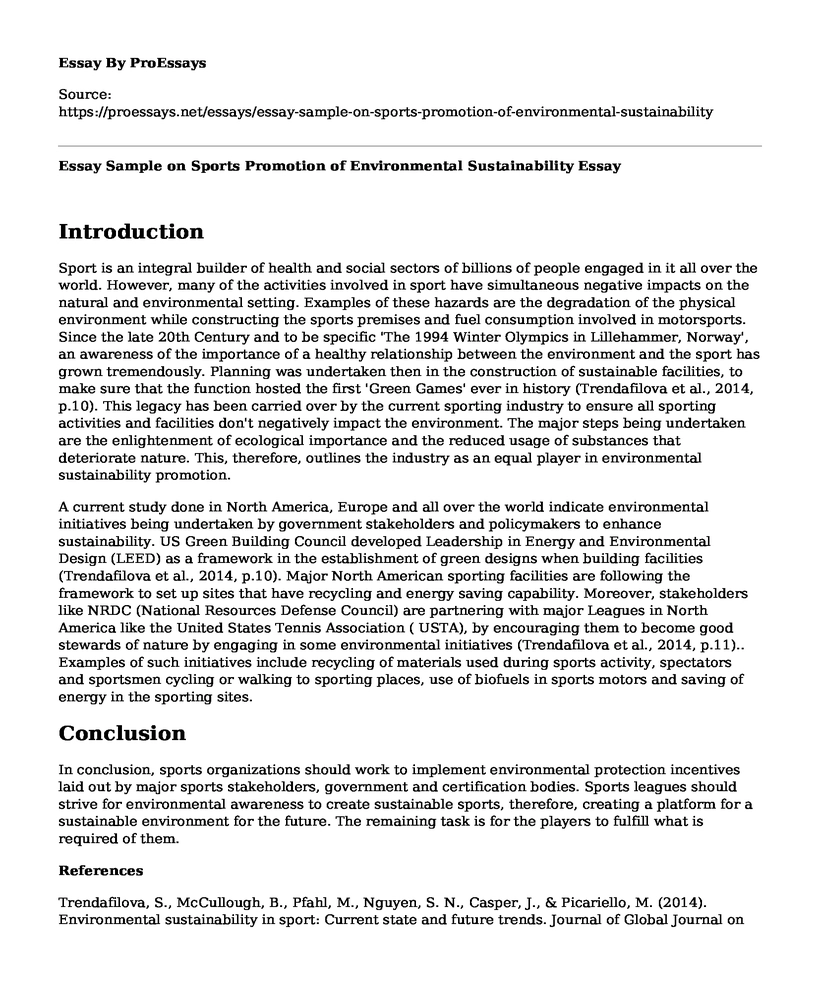Introduction
Sport is an integral builder of health and social sectors of billions of people engaged in it all over the world. However, many of the activities involved in sport have simultaneous negative impacts on the natural and environmental setting. Examples of these hazards are the degradation of the physical environment while constructing the sports premises and fuel consumption involved in motorsports. Since the late 20th Century and to be specific 'The 1994 Winter Olympics in Lillehammer, Norway', an awareness of the importance of a healthy relationship between the environment and the sport has grown tremendously. Planning was undertaken then in the construction of sustainable facilities, to make sure that the function hosted the first 'Green Games' ever in history (Trendafilova et al., 2014, p.10). This legacy has been carried over by the current sporting industry to ensure all sporting activities and facilities don't negatively impact the environment. The major steps being undertaken are the enlightenment of ecological importance and the reduced usage of substances that deteriorate nature. This, therefore, outlines the industry as an equal player in environmental sustainability promotion.
A current study done in North America, Europe and all over the world indicate environmental initiatives being undertaken by government stakeholders and policymakers to enhance sustainability. US Green Building Council developed Leadership in Energy and Environmental Design (LEED) as a framework in the establishment of green designs when building facilities (Trendafilova et al., 2014, p.10). Major North American sporting facilities are following the framework to set up sites that have recycling and energy saving capability. Moreover, stakeholders like NRDC (National Resources Defense Council) are partnering with major Leagues in North America like the United States Tennis Association ( USTA), by encouraging them to become good stewards of nature by engaging in some environmental initiatives (Trendafilova et al., 2014, p.11).. Examples of such initiatives include recycling of materials used during sports activity, spectators and sportsmen cycling or walking to sporting places, use of biofuels in sports motors and saving of energy in the sporting sites.
Conclusion
In conclusion, sports organizations should work to implement environmental protection incentives laid out by major sports stakeholders, government and certification bodies. Sports leagues should strive for environmental awareness to create sustainable sports, therefore, creating a platform for a sustainable environment for the future. The remaining task is for the players to fulfill what is required of them.
References
Trendafilova, S., McCullough, B., Pfahl, M., Nguyen, S. N., Casper, J., & Picariello, M. (2014). Environmental sustainability in sport: Current state and future trends. Journal of Global Journal on Advances in Pure & Applied Sciences, 3, 9-14. Retrieved from http://www.world-education-center.org/index.php/paas
Cite this page
Essay Sample on Sports Promotion of Environmental Sustainability. (2022, Oct 25). Retrieved from https://proessays.net/essays/essay-sample-on-sports-promotion-of-environmental-sustainability
If you are the original author of this essay and no longer wish to have it published on the ProEssays website, please click below to request its removal:
- Brain Disease and Football - Research Paper Example
- Research Paper on Industrial and Systems Engineering
- Nature of Magnetic Surfactants Essay Example
- Master Degree in Architectural Engineering - Admission Essay
- Fracture Mechanics of Composite Repair Methods for Steels and Structures - Research Paper
- Research Paper on Motivation of Athletes
- Annotated Bibliography on Coaches' Influence on Student-Athlete Motivation, Stress, & Skill







